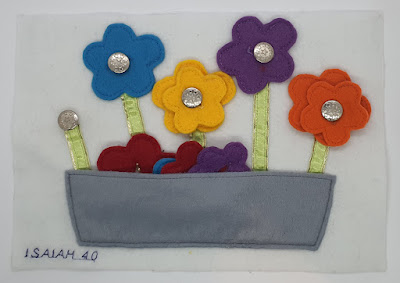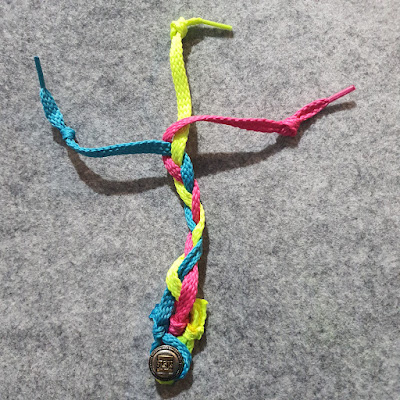In Isaiah chapter 40, God contrasts the faithfulness of His Word with that of all people.
Memory Verse: “All people are like grass,
and all their faithfulness is like the flowers of the field.
The grass withers and the flowers fall,
because the breath of the Lord blows on them.
Surely the people are grass.
The grass withers and the flowers fall,
but the word of our God endures forever.” Isaiah 40:6-8 (NIV).
Materials needed to create the Grass Withers and Flowers Fall quiet book page:
- A4 felt background sheet - I used white
- the free template from Jocelyn and Jason at The Quiet Book Blog
- felt scraps in gray, blue, orange, yellow, red and purple
- metal jean buttons
- green ribbon scraps
- sewing thread to best match the page
Cut five strips of ribbon for flower stems, melt the edges (How to Stop Ribbons Fraying). Sew them down onto your page, lining them up with where you want your flower heads to go, and ensuring the bottom ends will be covered by your planter box pocket.
Cut out your flower planter box from gray felt and sew it onto the same colour felt and cut out again. Sew it onto your page along the side and bottom edges to form a pocket.
Insert your jeans buttons at the top of each ribbon stem, adding extra felt behind for reinforcement. Button on your flower heads.
Finished! Now you can play with your page.
Difficulty Level = Easy, Difficulty level = No Sew
Jean button installation can be scary - but the following YouTube tutorial by OnlineFabricStore should help.
How to Attach a Jeans Button - OnlineFabricStore
Key Learning Areas and Skills
- Isaiah 40 - God's Word endures forever, unlike the faithfulness of people, who are like the grass and flowers that wither and fall so quickly and easily
- Buttoning - clasp and unclasp the hands as if they are "meeting together" or shaking hands greeting each other
- Pocket Play - young children love pulling things out and placing items and putting them back (not always lol) into pockets - the flower pieces can be stored in the planter box pocket
- Colour Matching - match the large and small flower petals together (or mis-match as desired)
- Fine Motor Skills - all quiet books encourage fine motor skill development
- Hand-eye Co-ordination - all quiet books encourage hand-eye co-ordination
Read the Chapter
Isaiah 40Devotional
The only thing we can trust is God and His Word. Everything else withers and falls as quickly and easily as the grass and flowers. He only is faithful.
Which colour flower is your favourite? Does it remind you of someone amongst your family or friends?















































